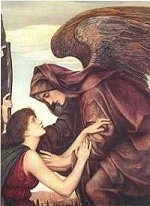 worked by God become ten plagues against Egypt, concluding with all Egyptian
firstborn dying on a night that sees the Hebrews spared, since they have been
instructed to anoint their door frames with lambs’ blood.
worked by God become ten plagues against Egypt, concluding with all Egyptian
firstborn dying on a night that sees the Hebrews spared, since they have been
instructed to anoint their door frames with lambs’ blood.
A Brief Synopsis of Exodus
I.
Exodus: The Deliverance Traditions (1-18)
A.
Israel in Egypt (1)
B.
The Early Moses (2-4)
C.
Plagues (5-11)
D.
Passover (12:1-13:16)
E.
Exodus from Egypt (13:17-15:21)
F.
Wilderness Journey (15:22-18:27)
II.
Sinai: The Covenant Traditions (19-40)
A.
Theophany on the Mountain (19)
B.
Law and Covenant (20-23)
1.
Ten Commandments (20:1-17)
2.
Book of the Covenant (20:18-23:33)
C.
Covenant Confirmation Ceremony (24)
D.
Tabernacle Design (25-31)
E.
Covenant Breaking and Remaking (32-34)
1.
Golden Calf (32)
2.
Covenant Renewal (33-34)
F.
Tabernacle Construction (35-40)
Hebrew Scriptures identify their books of scripture by how they begin the narrative; thus, Exodus is called ’ēlle[h] š∂môt (“These are the names of…”), rendered in the Greek as Exodos (“road out, exit”), and Latinized as Exodus for the second book of the Torah. After what may be approximately three centuries, the Egyptians fear the numbers of the Hebrew people; so Pharaoh first enslaves them and then determines that he must kill the male newborn children. The king’s daughter, spares a child she finds in the water, and raises him in the palace as her own.
We are as well, that Pharaoh will not listen to Moses and his brother Aaron, who
accompanies him, because Yahweh has hardened the heart of the king so as to not
listen to pleas. The resulting miracles
 worked by God become ten plagues against Egypt, concluding with all Egyptian
firstborn dying on a night that sees the Hebrews spared, since they have been
instructed to anoint their door frames with lambs’ blood.
worked by God become ten plagues against Egypt, concluding with all Egyptian
firstborn dying on a night that sees the Hebrews spared, since they have been
instructed to anoint their door frames with lambs’ blood.
Pharaoh releases the Hebrews but almost immediately changes his mind, seeking to attack them with their backs to the sea; Yahweh intervenes again, and the sea parts, permitting the Hebrews, lead by
The jubilant Israelites, descendants of the twelve sons of Jacob, whose named was changed to Israel, wander into the wilderness on their way back to God’s mountain, Mount Horeb, also called Sinai. Many scenes of discontent and miracles take place, as the Israelites grow discontented and scared but are saved by miracles of food from heaven and protection against tribal attacks. At the foot of the mountain, Moses, with the aid of his father-in-law, Jethro, establish what is called the Israelite judiciary, and Moses reveals the Covenant Tablets he received of God, as well as instructions for building the earthly habitation of God, the Tabernacle.
However, in Moses’ absence, the weak Israelites again backslide, making and worshipping a golden calf. In anger, Moses smashes the tablets received from God, but manages to intercede with God on behalf of the Israelites, renews the Covenant, and receives additional laws from God. The craftsman Bezalel directs the construction of the Meeting Tent, which is consecrated shortly before the anniversary of their departure from Egypt.
The conjectured route of the Israelite Exodus; note where Mount Sinai is in relation to Goshen and Canaan. Most of us don't realize the proximity of the lower Nile to Hebron and Jerusalem, which implies a closer and thus greater relationship between the cultures of Egypt and what would become Israel.